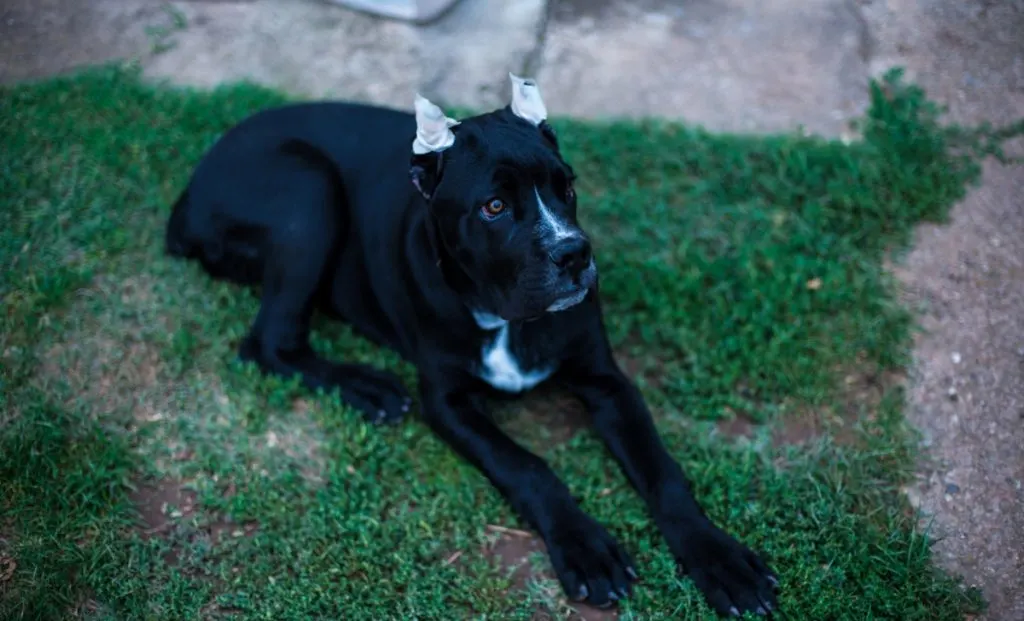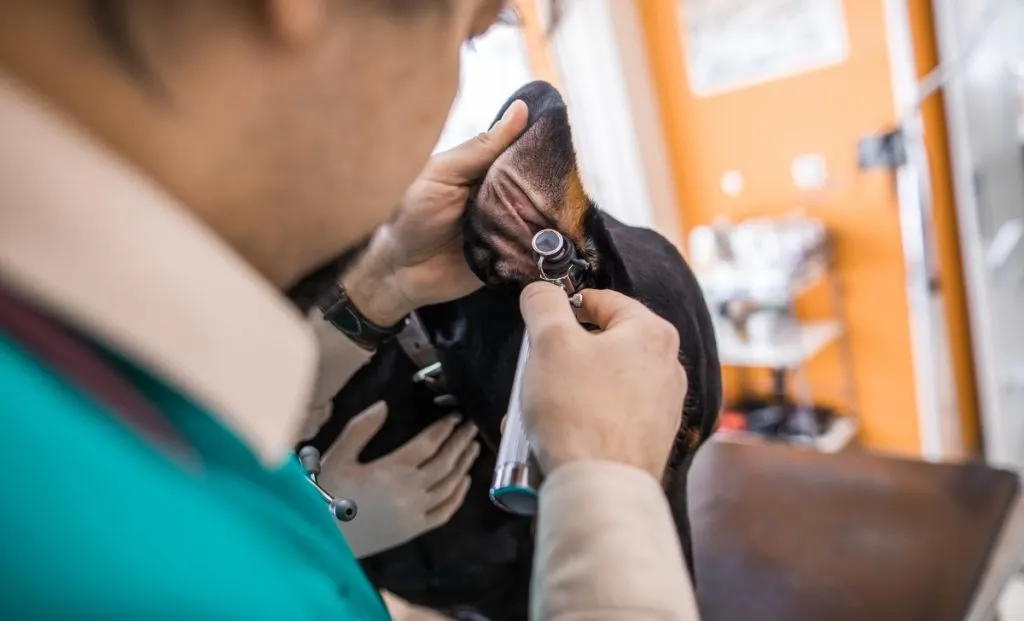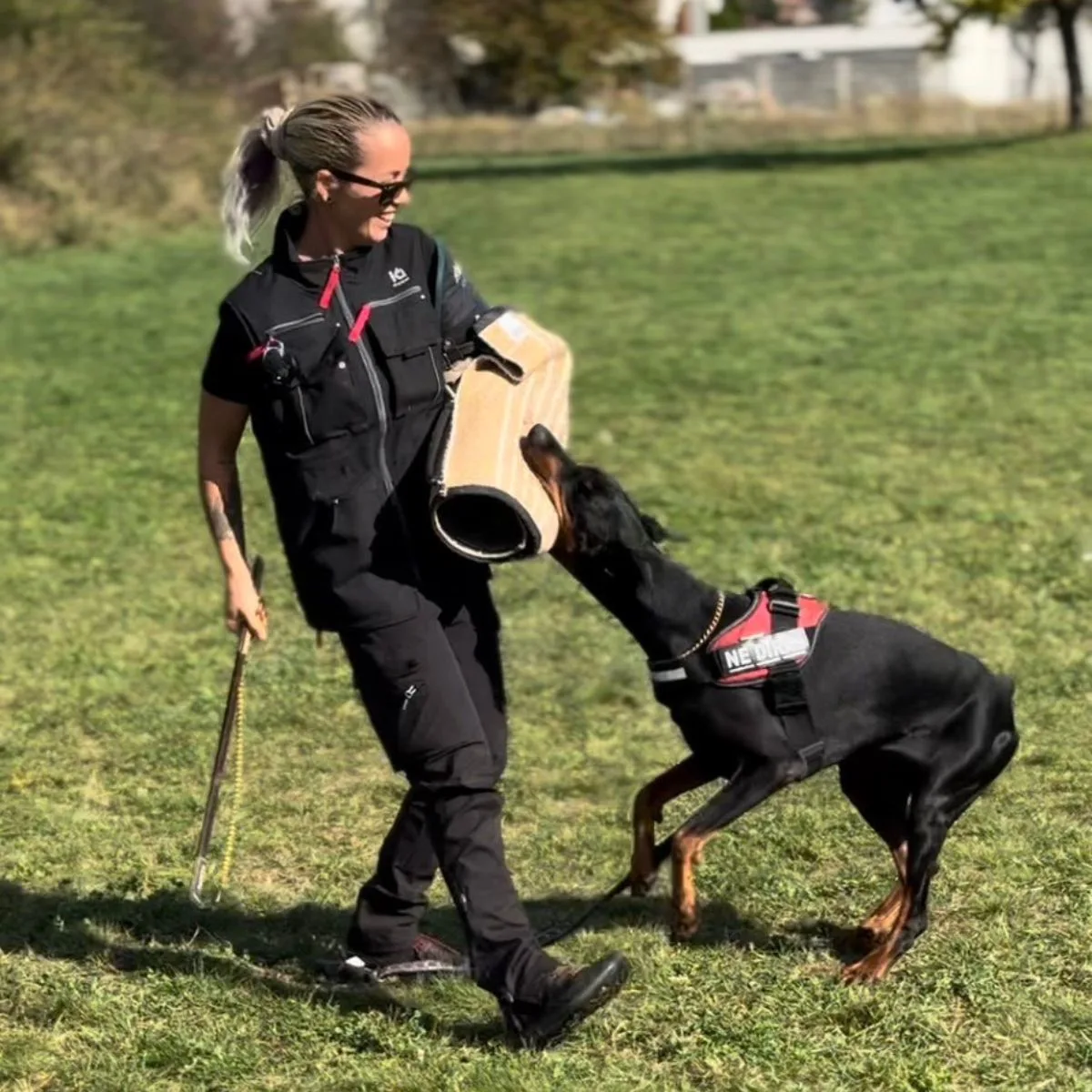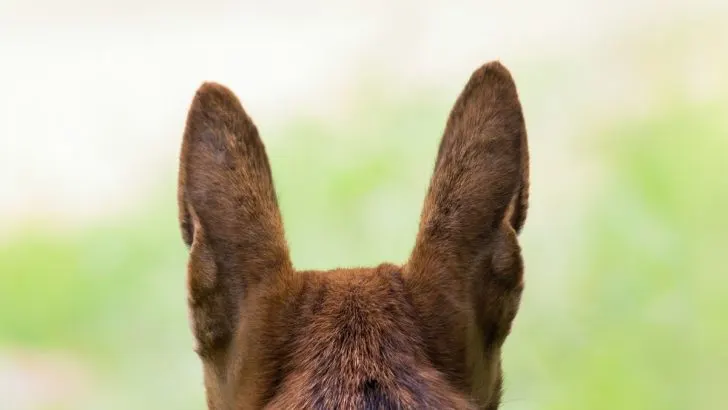Dog ear cropping is quite a controversial topic nowadays. Half of the dog enthusiasts and owners don’t understand why do people crop dogs’ ears. The other half can’t imagine their dog with floppy ears.
Ear cropping is an elective surgery done under general anesthesia for approximately 20 dog breeds, including Great Danes, Dobies, Schnauzers, Boxers, American Pitbull Terriers, and many others.
During the procedure, veterinarians help with the surgical removal of most or all the flappy parts of the ear. Taping the ear follows the surgical procedure to ensure the ear cartilage is in the desired position.
We can’t talk about cropping without touching the topic of docking. Docking is the procedure of removing a part of the dog’s tail.
In many countries, routine tail docking is considered unacceptable by most vets (83 to 92%) (1) and the general public (68 to 88%) (2). In contrast, breeders with a prior commitment to this practice favor tail docking. (3)
If we look at this historically, this type of surgery was usually implemented because of practical reasons for the breeds mentioned above. Different breeds had different reasons for ear cropping and tail docking.
Most often, the reasons were hunting, fighting, or the dogs were working dogs. If we look at some livestock guardian and herding dogs, they got their ears cropped because it was thought to improve their hearing.
Today, however, it is mainly considered a cosmetic procedure and has been banned in many countries. It is still legal in most of North America. If you are considering pursuing an ear crop or tail dock on your puppy, there are some things to consider beforehand.
What’s The Purpose Of Tail Docking And Ear Cropping

Man’s best friend’, the pup, was domesticated by our race about 15.000 years ago. (4) Since then, dogs have remained an essential part of society in many cultures worldwide.
From artifacts and pottery, we can notice a genetic selection beginning about 7500 years ago. (5) The intense artificial selection resulted in 152 recognized dog breeds. (6)
It is estimated that about 37% to 47% of households in the United States have a dog, equal to about ~70 to 80 million owned dogs. (7) When we look for a potential breed, many factors come into play.
Although personality is a crucial reason for relinquishment, aesthetics seem to be the most critical factor in choosing a dog breed. That results in a dog breeding industry that is primarily appearance-driven. (8)
Breed standards are there to outline distinct characteristics, such as height, color, and body conformation (you can look up breed standards that are set out by the American Kennel Club (AKC) and the Canadian Kennel Clubs (CKC)).
Along with this approach to genetic selection, some breed standards include details regarding the length of the dog’s tail or position of the ears, which in some dog breeds can only be achieved through surgical removal (tail docking and ear cropping).
Cosmetic Purposes
Yes, it is true; some owners remove long ears or tails purely for cosmetic purposes. Let’s look at a study published on June 27, 2016, titled “Tail Docking and Ear Cropping Dogs: Public Awareness and Perceptions“.
The research was conducted with veterinarians and dog breeders familiar with both practices. The project had three aims: to assess public awareness of tail docking and ear cropping and to determine whether a dog’s physical alteration affects how the dog is perceived and how the owner is perceived.
42% of participants (number of participants = 810) could not correctly explain why tail-docked and ear-cropped dogs had short ears and tails.
Similarly, most test subjects believed docked tails and cropped ears resulted from genetics rather than something the owner or breeder had done.
The results from experiment two (number of participants = 392) provide evidence that ear-cropped and tail-docked dogs are perceived differently than the same dog in its natural state.
Modified canines were perceived as more aggressive and dominant, less playful, and less attractive than their natural counterparts.
Experiment three (number of participants = 410) is the first objective evidence that owners of modified dogs are sensed as being more aggressive, selfish, less playful, less talkative, and less warm than natural dog owners.
Medical And Health Reasons

Just like any form of surgery, this is sometimes a required surgical procedure. There are various ways a dog can earn an ear injury. Some are more serious than others and require ear cropping.
If we look at historical reasons for cropping dogs, during the Roman times, dogs had their tails docked or removed as a way to minimize the spread of rabies. (9)
The ear cropping was implemented to prevent possible ear damage during hunting or fighting. (10)
In modern times, the reasoning behind the docking and cropping surgery includes the prevention of tail injuries (11), decreasing the possibility of ear infections, breed standards, and the breeder’s right to choose. (12)
Unfortunately, relatively little research has actually been done to validate those assertions. (10, 13)
Despite the lack of concrete evidence, ear cropping and tail docking have become essential features of many dog breeds.
Historically, about one-third of recognized dog breeds have their tails docked (13), but to our understanding, there are no reliable assessments of the extent to which these procedures are performed nowadays.
Working Dogs
They are done for practical purposes when we talk about ear cropping and tail docking in working and guard dogs.
Even in counties where cropping and docking are illegal, some exemptions allow certain types of working dogs to have the tails docked by a qualified veterinarian surgeon.
The dog can not be more than five days old. The chosen veterinary surgeon must certify that he or she has seen evidence that the dog is likely to work in one of the specified areas.
Any spaniel, terrier, hunt point retrieve breed, or their crosses can be docked (as long as the necessary evidence indicating that they are likely to work is produced).
Some of the often-cited reasons to do a tail dock on working dogs include:
- Any guard dog could be seized by the tail to prevent its attack. (14)
- Hunting dogs, such as pointers, might damage their tail tip in the underbrush. (15)
- Long-haired dogs might quickly become more soiled and dirty if they have a hanging tail. (16)
The reasoning behind docking working dogs’ tails does not have substantial scientific support. In the most extensive study to date on tail injuries in pups, the incidence was 0,23 percent, and it was calculated that about five hundred pups need to be docked to prevent one tail injury. (17)
However, it has been suggested that certain breeds, or dogs used for specific purposes, have a more significant percentage of tail injury.
An uncontrolled study of German shorthaired pointers done in Sweden suggested there might be an elevated level of tail injury as a repercussion of a ban on docking. (18)
The actual differences between dog breeds that are docked and those that are not are minor.
For example, the very similar Pointer, the German Long-haired Pointer, and the German Shorthaired Pointer, only the German Shorthaired Pointer is traditionally docked. (19)
Different Crop Styles

Depending on the functionality of the ear crop, we have three different cropping styles.
- Short Crop – The short crop is best with flat-headed dogs like the Staffordshires. This crop leaves about one-third of the original ear.
- Medium Crop – One of the most requested ear crops. It is medium length and gives the dog an overall alert look. It is also best with dogs that have a rounded head or an asymmetrical marking up the middle of their face/muzzle. This crop is typically quite hard to get to stand correctly.
- Tall Crop or show crop – This is the most extended ear crop available for dogs. It’s usually done for show dogs. It is best for dogs that have almond-shaped heads and ears lower down on the skull. This type of cropping leaves the dog with about three fourths of the original length of the ear. It’s a typical crop we can notice in the show ring.
Legal Aspects Of Ear Cropping
Increasing concern about dogs and their well-being has led numerous people to question the practices of ear cropping and tail docking. Multiple countries have introduced legislation that restricts, and in some cases even prohibits, these practices altogether.
For example, let us look at the European Union Convention on the topic of the protection of pet animals.
They prohibit surgical operations, including tail docking and ear cropping, for non-curative purposes in most European countries. (19)
In Israel, docking is banned for cosmetic purposes, while Scotland implemented a complete ban in 2003. (20) We can find an enormous variation in the amount of restriction placed on ear cropping and tail docking.
In North America, organizations like the American Veterinary Medical Association (AVMA), just like the Canadian Veterinary Medical Association (CVMA), made official position statements opposing these practices for any cosmetic purposes.
As a result, some Canadian provinces and U.S. states (for example, Pennsylvania and Maryland) have even passed by-laws that ban tail docking and, in some cases, also ear cropping.
Also, it is essential to note that most notable veterinary textbooks no longer contain procedural outlines for ear cropping. (21)
Should I Crop My Puppy
If you are looking into the traditionally cropped breed like the Doberman Pinschers, you might get a feeling that the droopy ears are frowned upon. However, ear cropping is a personal preference for you as an owner.
Many owners prefer that dogs’ ears stand in an upright position for various reasons. If you decide to go forward with cropping or docking, make sure you go to a vet who knows what he or she is doing.
This elective surgery must be performed by someone who specializes in cropping and docking because expert cropping of ears is more of an artistic endeavor than a technical surgical procedure such as spaying or neutering.
There is no set amount of time it takes before the dog’s ears will stand upright; the average time for taping is approximately 4 to 5 months.
Most dogs have their ears up by the age of 6 or 7 months. That said, it isn’t unusual for some ears not to stand until the pup is a year old.
We can notice some puppies have poor ear leather, which means that the ears won’t ever stand perfectly or the tips will curl inward. These problems can also be the result of a poor ear crop.
There are many methods of aftercare and healing process. Achieving perfect ears that stand correctly requires commitment and time on the owner’s part. Consider the benefits and cons before deciding on an ear crop or a tail dock.
References
1. Bennett PC, Perini E. Tail docking in dogs: can attitude change be achieved? Aust Vet J 2003;81:277-82.
2. Submission to Government Administration Committee presented by Royal New Zealand Society for the Prevention of Cruelty to Animals Incorporated in the matter of animal welfare (restriction on docking of dogs’ tails) bill. February 25, 2005.
3. Council of Docked Breeds Web site. U.K. Tail Docking Survey Available at: http://www.dockingsurvey.org Accessed March 26, 2024
4. Wayne RK, von Holdt BM. Evolutionary genomics of dog domestication. Mamm Genome. 2012;23: 3–18. 10.1007/s00335-011-9386-7
5. Pedersen N, Liu H, Theilen G, Sacks B. The effects of dog breed development on genetic diversity and the relative influences of performance and conformation breeding. J Anim Breed Genet. 2013;130: 236–248. 10.1111/jbg.12017
6. Parker HG, Kim LV, Sutter NB, Carlson S, Lorentzen TD, Malek TB, et al. Genetic structure of the purebred domestic dog. Science. 2004;204: 1160–1164.
7. American Society for the Prevention of Cruelty to Animals. Pet Statistics. 2015;8: 13 Available: https://www.aspca.org/about-us/faq/pet-statistics.
8. Asher L, Diesel G, Summers JF, McGreevy PD, Collins LM. Inherited defects in pedigree dogs. Vet J. 2009;182: 402–411. 10.1016/j.tvjl.2009.08.033
9. Swabe J. Veterinary Dilemmas: ambiguity and ambivalence in human-animal interaction In Podersbeck A, Paul E, Serpell J, editors. Companion Animals and Us: Exploring the relationships between people and pets. Cambridge: Cambridge University Press; 2007. pp. 292–312.
10. Mills K, von Keyserlingk MAG, Niel L. A review of medically unnecessary surgeries in companion animals. J Am Vet Med Assoc. 2016; 248:162–171. 10.2460/javma.248.2.162
11. Diesel G, Pfeiffer D, Crispin S, Brodbelt D. Risk factors for tail injuries in dogs in Great Britain. Vet Rec. 2010;166: 812–817. 10.1136/vr.b4880
12. Council of Docked Breeds. 2010; 3: 6 Available: http://www.cdb.org/.
13. 13. Bennett PC, Perini E. Tail docking in dogs: a review of the issues. Aust Vet J. 2003;81:208–218.
14. Coren, S. How Dogs Think: Understanding the Canine Mind. Simon and Schuster, 2004; 106
15. Lee RB. A History and Description of the Modern Dogs of Great Britain and Ireland. H. Cox: London. 1897. p. 220-221.
16. Sasson-Brickson G. The bobtail trait in Australian shepherds – part I: a historical perspective and docking Regulations in various countries. Aussie Times 2005; March-April
17. Diesel G, Pfeiffer D, Crispin S, et al. Risk factors for tail injuries in dogs in Great Britain. Vet Rec 2010;166:812-817.
18. Strejffert G. Tail injuries of shorthaired German point dogs born in Sweden 1989, 1992 http://www.cdb.org/countries/sweden.htm Accessed 30. March 2024
19. Beaver B. Distance-increasing postures of dogs. Vet. Med. Small Anim. Clin. 1982;77:1023–1024.
20. Blackshaw J. Human and animal inter-relationships. Review series: 3. Normal behavior patterns of dogs. Part 1. Austr. Vet. Pract. 1985;15:110–112.
21. Henderson R, Horne R. The pinna In Slatter D, editor. Textbook of minor animal surgery Volume 1. 3rd ed. Philadelphia: Saunders Elsevier Science; 2003. pp. 1737–1746.

Nandina has been a lifelong dog owner and enthusiast. She shared her home with multiple breeds, including Giant Schnauzers, Cane Corsos, and Huskies. Currently, she is raising a three-year-old rescue and a working-line German Shepherd puppy.
Actively engaged in IGP dog sports for two years, Nandina is a certified instructor for basic obedience and socialization. She works as a trainer in her local dog sports club, and in her spare time, she handicrafts biothane gear for dogs.
